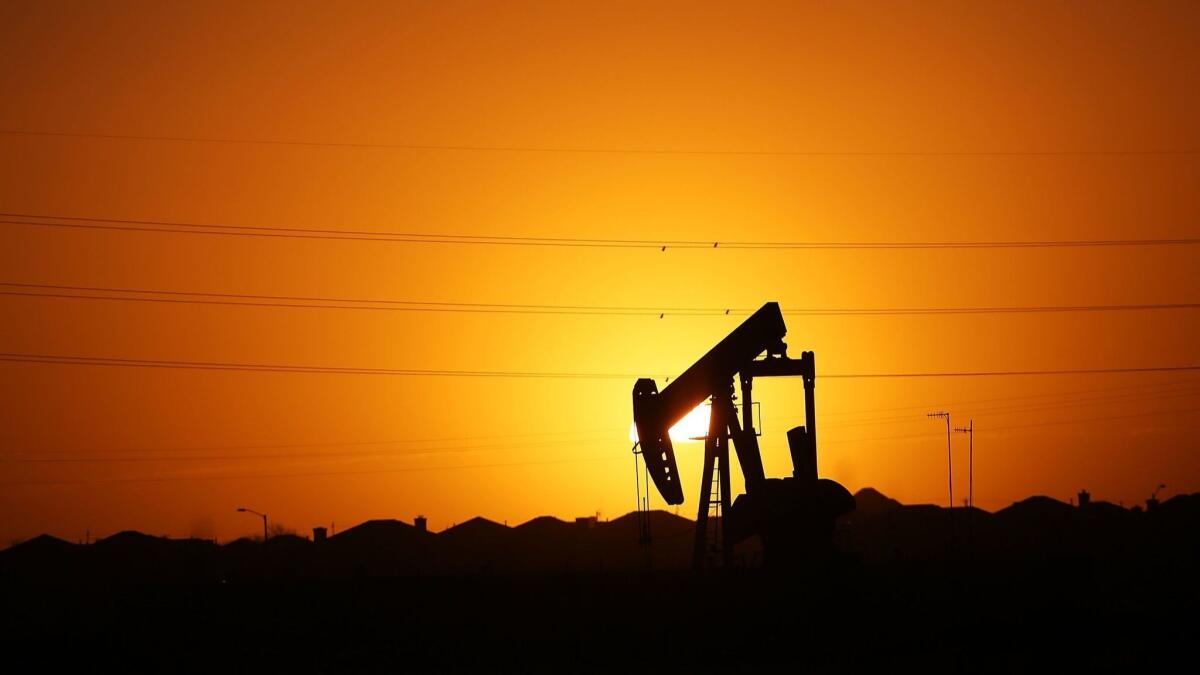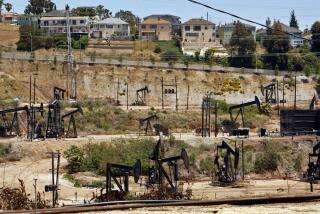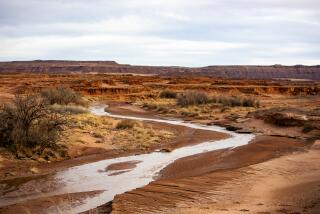Here’s why New Mexico’s oil boom is raising a lot of questions about water

- Share via
Reporting from Carlsbad, N.M. — Massive oil drilling rigs stretch across the horizon here like giant carnival rides — 85 in all, lighting the night sky across two counties that sit atop one of the biggest fossil fuel deposits in the nation.
Southeastern New Mexico has long been a modest producer of oil, but the advent of fracking technology a decade ago turned it into hot property for drillers. Only Texas and North Dakota now extract more oil, and New Mexico is gaining.
Production grew 30% last year to 565,000 barrels a day, almost all of it from the state’s portion of the Permian Basin surrounding Carlsbad. Billions of barrels more remain to be tapped in shale deposits 2 miles deep.
Producing massive quantities of one resource requires extreme care for another: water. The risk that fracking can contaminate water supplies and cause other harm has been well documented, from Wyoming to Pennsylvania. But experts say that nowhere is that risk greater than in southeast New Mexico.
“Conditions here are unique,” said Ed Martin, assistant commissioner in the New Mexico State Land Office, which manages nearly 2 million acres of state land for energy production. “The volumes of water the industry uses are so prolific. The disposal problems are more pronounced. The potential for something to go wrong is higher.”
Fracking involves injecting a torrent of chemicals, sand and millions of gallons of water into wells under ultra-high pressure to crack formations of fuel-saturated shale. The high pressures can damage well casings, causing ruptures that leak. And the process generates huge amounts of liquid waste that must be transported for disposal or recycling.
Raising the danger in New Mexico is the area’s distinctive geology. Underlying the region are thick beds of salt, which abut the porous limestone formations that hold much of the region’s drinking water.
The geology is so uncommon that in 1923 the United States established an underground national park, Carlsbad Caverns, to make nearly 47,000 acres of magnificent limestone caves permanently available for bat habitat and human exploration.
The massive salt formations also make an ideal place to store radioactive waste from atomic weapons production. The Waste Isolation Pilot Plant, the nation’s only permanent nuclear waste repository, is located 2,150 feet underground.
Drilling for oil in New Mexico involves specialized practices.
The state and the federal Bureau of Land Management, which oversees 3 million acres and thousands of wells in southeast New Mexico, require three layers of steel and cement casing around wells to prevent ruptures in porous limestone.
Drilling through the limestone requires fresh water to prevent contamination of drinking water. But drilling through salt requires brine, because fresh water would dissolve the salt formations and would make wells structurally unstable.
Either way, drilling unearths massive quantities of fluid known as “produced water” that must be drained from the wells. Each day, 115 million gallons of it is brought up to the surface and trucked or piped across the oilfield.
About half is treated and recycled, and the other half injected into 721 wastewater wells meant for permanent disposal of the fluid.
Fracking the wells to release the oil requires more water — 34 million gallons for a single well just under 2 miles deep, according to the state. Nearly half comes back to the surface, and most of that is injected into the waste wells.
With wells being drilled at a record pace — there are currently 26,000, with 600 new ones being added each year — the risk is continually increasing. Studies conducted by the federal Bureau of Land Management show that oil and toxic materials from a big spill or leak could move quickly and contaminate thousands of acres of underground aquifers that supply the region’s drinking water.
“New Mexico’s Permian Basin has a 50-year supply of oil,” said Aubrey Dunn, the state land commissioner. “We need to be careful to make sure we have a 50-year supply of fresh water.”
The potential for significant damage is ever-present. The state Oil Conservation Division documented almost 800 surface spills or leaks last year in the two counties — Eddy and Lea — where most of the fracking occurs. About 10,000 barrels of oil and 75,000 barrels of production fluid were spilled.
None of it reached groundwater, according to state and federal officials.
“There is no evidence of groundwater contamination” associated with fracking or wastewater disposal in state history, said Beth Wojahn, a spokesperson for the state’s Energy, Minerals and Natural Resources Department, which oversees energy development.
Ground-water contamination related to fracking is very rare everywhere, but when it occurs, the consequences can be dire. Cleanup is costly and generally only possible if caught quickly.
New Mexico officials say they are confident that regulations and an ample number of inspectors can prevent such contamination.
The state’s track record on managing the oil industry’s use of water, though, doesn’t inspire confidence.
For decades, oil field services companies poured millions of gallons of freshwater into the ground to dissolve a thick salt layer and produce brine long used in drilling operations. In the process, they hollowed out massive caverns. A decade ago, two of those collapsed, forming a pair of giant desert craters 22 miles and 29 miles northeast of Carlsbad, the heart of the state’s oil operations.
Now authorities are scrambling to prevent another collapse that would be far more damaging. This cavern — 700 feet long, nearly 500 feet wide and 450 feet deep — isn’t in the remote desert but on the edge of town, under a major highway and several businesses. New Mexico officials recently agreed to spend $40 million to figure out how to stop that from happening.
“The latest engineering report said that the collapse is going to happen,” said George Veni, director of the National Cave and Karst Research Institute, a geological sciences group based in Carlsbad. “Not if, but when. It could happen anytime, but 2021 is more likely.”
ALSO
EPA chief signals a showdown with California over fuel economy rules for automakers
The biggest solar parks in the world are now being built in India
Trump has big plans for offshore oil development. But will it ever happen?
Schneider is a special correspondent.
More to Read
Sign up for Essential California
The most important California stories and recommendations in your inbox every morning.
You may occasionally receive promotional content from the Los Angeles Times.










